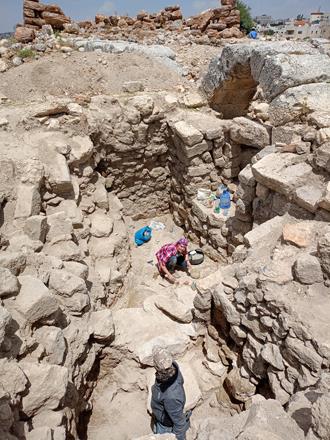
Khirbat As-Sar: Archaeological Insights Into Ammonite, Roman, Islamic Eras
Therefore, it enjoyed considerable strategic importance in antiquity. The site was first noted in the late 19th century by S. Merrill (1881) and C.R. Conder (1889); after that, it was shortly described by H.C. Butler (1919) and N. Glueck (1937), and in later years, it was included in archaeological surveys conducted by F. Villeneuve (1983) and Chang-ho Ji (2000), noted Professor Emerita at the Faculty of Archaeology University of Warsaw Jolanda Młynarczyk.
"Beginning with H.C. Butler, all the researchers emphasised the presence of an 'Ammonite tower' at the site's highest point, arcades of the Roman period, and unspecified architectural remains of the Islamic period," Młynarczyk said, adding that despite its spectacular character, the ancient name of Khirbat es-Sar has remained unknown to this very day.
Noteworthy may be the suggestion by both Merrill and Conder that the site should be identified with biblical Jazer; according to Conder, it would be the same site as Azor, mentioned by bishop Eusebius, who wrote that during his time (that is, early 4th century CE) there was a village Azer (Iazer) situated on the border of Ammanitis, distant about eight (Roman) miles from Philadelphia (modern Amman), Młynarczyk elaborated, adding that this description fits the site of Khirbat es-Sar perfectly well.
"On the other hand, as regards the Hellenistic period, one may consider the possibility that Khirbat es-Sar would be the same as 'Birta of the Ammanitis', mentioned in a papyrus of 259 BC, belonging to the so-called Zeno archive found in the Fayoum in Egypt. This 'Birta'[the Fortress] is traditionally regarded as referring to the Citadel of Amman; however, another papyrus from the same archive and the same period mentions Amman as 'Rabbatammana' suggesting that 'Birta of the Ammanitis' may be situated somewhere else, possibly at Khirbat es-Sar, given its excellent strategical position on the road to Amman," Młynarczyk explained.
The excavations by the University of Warsaw, first of all, confirmed the primary chronological sequence of Khirbat as-Sar as noted by previous researchers: the qasr ("Ammonite tower") built in the Iron Age, subsequently converted into a temple by the Romans who added a vestibule to the eastern side of the qasr and a spacious courtyard flanked by arcades; finally, the remains of an intense Islamic-period occupation spreading above the Roman layers. Thus, the occupation of Khirbat as-Sar spans the late Iron Age (7th /6th century BC) through the Middle Islamic period (15th/16th century AD).
"It is very important to note that our excavations provided the very first insight into the stratigraphy of Khirbat as-Sar and allowed us to distinguish several chronological phases, hitherto unspecified precisely, namely: Late Roman/Byzantine, Early Islamic (Umayyad through Abbasid), Fatimid, Ayyubid and Mamluk. Finally, an early Ottoman period has been recorded by makeshift stone fences and fireplaces, accompanied by potsherds and animal bones," Młynarczyk underlined.
"An essential objective of our research was to determine the construction date of the 'Ammonite tower'; therefore, a trench was opened on the northern side of the qasr. The lowest course of its foundation reached 4.5m below the present-day ground level; unfortunately, instead of stratigraphical layers, it revealed a buttress constructed by the Romans to support this particular section of the Ammonite structure,"Mariusz Burdajewicz from University of Warsaw said, adding that the latest pottery retrieved from this trench indicates that it took place about the mid-2nd century AD, which is perhaps also the date of the transformation of the qasr into the temple's cella.
Although many fragments of Iron Age storage jars were present in the trench, the precise date of the construction of the qasr remains to be determined.
Burdajewicz added that another trench was opened against the Roman period addition on the eastern side of the qasr; this addition has been interpreted as the vestibule of the temple.
"Therefore, one would expect the presence of a staircase leading from the courtyard up to the temple. However, the trench exploration did not reveal any steps; presumably, they were dismantled and removed after the temple fell into disuse during the Byzantine period," Burdajewicz highlighted, noting that instead, two phases of Ayyubid/Mamluk-period habitations were identified by walls and simple earthen floors.
Below them, the team found remains of the metallurgical workshop with a furnace used for iron smelting. The workshop, dated to the Abbasid period (8th /9th century AD) by accompanying pottery, was resting upon a thick layer of the destruction of a rather impressive building constructed of ashlars.
It yielded fragments of roof tiles and other building elements such as a collapsed pillar, a molded cornice, wall plaster, and a mosaic floor.
"There is little doubt that this violent destruction resulted from an earthquake of 749 AD, meaning the building belonged to the Umayyad period. The extent and the function of the building will be investigated shortly," Burdajewicz underscored.

Legal Disclaimer:
MENAFN provides the
information “as is” without warranty of any kind. We do not accept
any responsibility or liability for the accuracy, content, images,
videos, licenses, completeness, legality, or reliability of the information
contained in this article. If you have any complaints or copyright
issues related to this article, kindly contact the provider above.
Most popular stories
Market Research
- Thinkmarkets Adds Synthetic Indices To Its Product Offering
- Ethereum Startup Agoralend Opens Fresh Fundraise After Oversubscribed $300,000 Round.
- KOR Closes Series B Funding To Accelerate Global Growth
- Wise Wolves Corporation Launches Unified Brand To Power The Next Era Of Cross-Border Finance
- Lombard And Story Partner To Revolutionize Creator Economy Via Bitcoin-Backed Infrastructure
- FBS AI Assistant Helps Traders Skip Market Noise And Focus On Strategy




















Comments
No comment